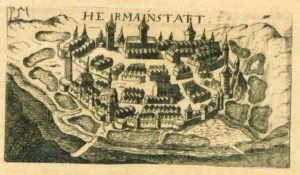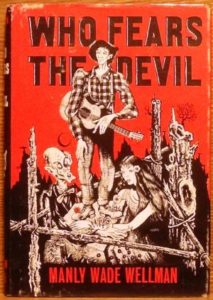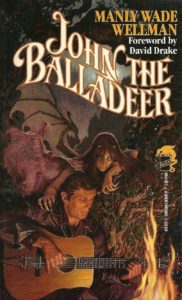The Other Kind of Magic School: The Deep School
article by Denton Salle 12 January 2018
Most, if not all, of the magical boarding schools in stories today are mostly pleasant or at least non-malign places. There are a lot of them as boarding schools make good settings for stories. Lamplighter’s Roanoke Academy, Nuttall’s Whitehall School, Raley’s Institute of the Elements, Lackey’s Harton School, and, of course, Rowling’s Hogwarts all are made to sound as interesting places to study. Whether this is true can be contested. Some are more formal and structured than others. However, there is a school that makes worse seem pleasant and the Slytherin folks seem like the good guys. For those seeking the best in evil magic, one can attend the Deep School.

The Elizabethan magus: John Dee
Magic until quite recently was looked at as coming either from God or the Devil. On the former side, we have legends of Albertus Magnus and Dr. John Dee calling on Holy Names and the angelic powers. Most magic, however, was a function of pacts with the devil and he’s who one went to learn magic. Often this was an individual deal – think of witches or Dr. Faust- but some people would seek out the Deep School, also called the Scholomance or Dark School, in one of its locations or forms. Often these were associated with centers of learning like Salamanca and Paris, where the Devil could poach scholars who were interested in topics not available at the University. Things like necromancy, talking to animals, summoning spirits, shape changing – those interesting topics that might just cause eternal damnation. Those hardcore Faustian types could seek out and apply to the Deep School. It’s not for nothing that the path to hell is lined with the bones of errant clerics.

The Scholomance was said to be in Hermainstatt
Of course, it’s not just scholars and clerics who lust after the Devil’s knowledge as the knowledge of the unseen and of dark magics grant one powers and luck not available to normal men. Hidden treasure can be found, luck in war, love, or business can be obtained, and dark deeds done. St. Cyprian, a graduate of the several Dark Schools, used his powers to make himself wealth and powerful until St. Justina of Antioch caused his conversion. Sir Francis Drake supposedly attended the School of the Night in Devon, where he gave his soul to the Devil for his seafaring skills and battle luck. He also learned the magic he used to call the storms that destroyed the Armada. Interesting, like another graduate, he was called the Dragon by his enemies and his arms bore one. There was also another School of Darkness in Scotland where the witches tried to kill King James’ future Queen by calling storms to sink her ship. Their descendants escaped to re-establish the school in the Colonies which lasted until the 1950 when John Thunstone and company shut it down.

Sir Francis Drake — just how did he stop the Spanish Armada?
Located in the Transylvanian mountains of lost Carpathia-Russia, one finds the Scholomance. Several travelers (1) have reported local legends of the school in Romanian and German, which were later translated into English. Both the Romanians and the Lemkos (2) tell of this school for dark wizards and its horrible cost. The Scholomance, as Van Helsing as reported in Bram Stoker’s Dracula, was associated with the Dracula family, sharing their dragon emblem. He tells us that “The Draculas were, says Arminius, a great and noble race, though now and again were scions who were held by their coevals to have had dealings with the Evil One. They learned his secrets in the Scholomance, amongst the mountains over Lake Hermannstadt, where the devil claims the tenth scholar as his due.” Later he specifically mentioned that Vlad Tepes himself: “dared even to attend the Scholomance, and there was no branch of knowledge of his time that he did not essay.” In exchange for your immortal soul and risking your body, one gained knowledge of all living languages – human and not, of all arts and sciences, of summoning and binding spirits and demons, of hidden treasures, and of darker magics.
 It waited until Manly Wade Wellman for someone to tell more of the detailed experiences of the Deep School and he does this from both John Thunstone’s and Judge Pursuivant’s stories. Students were taught in the dark with either books with letters of cold fire or lessons written on the wall in glowing script. Once accepted as a full student, the student shunned sunlight for the seven years of his classes and many left broken and sickly from the stress and trials of the school. Those who survived and were still well enough to use what they learned prospered greatly. The grimoires they created writing their lessons were greatly desired as the spells and magics in them were greater than those recorded else. People who survived the Deep School were at risk of being murdered by those without the courage to attend, in addition to the loss of their souls at death. The distinctive books, bond in a hairy skin with pages of white, red, and black, were greatly treasured and coveted. For where else could one learn of what the blue flames that burn on St. John’s Eve mean, how to steal the heart of a maid, summon the Princes of Hell, or how to make kings and princes trust your every word?
It waited until Manly Wade Wellman for someone to tell more of the detailed experiences of the Deep School and he does this from both John Thunstone’s and Judge Pursuivant’s stories. Students were taught in the dark with either books with letters of cold fire or lessons written on the wall in glowing script. Once accepted as a full student, the student shunned sunlight for the seven years of his classes and many left broken and sickly from the stress and trials of the school. Those who survived and were still well enough to use what they learned prospered greatly. The grimoires they created writing their lessons were greatly desired as the spells and magics in them were greater than those recorded else. People who survived the Deep School were at risk of being murdered by those without the courage to attend, in addition to the loss of their souls at death. The distinctive books, bond in a hairy skin with pages of white, red, and black, were greatly treasured and coveted. For where else could one learn of what the blue flames that burn on St. John’s Eve mean, how to steal the heart of a maid, summon the Princes of Hell, or how to make kings and princes trust your every word?
 While the entrance to the school is underground, it appears classes were actually held in another world, most likely a suburb of hell. After committing to the course of study with an act of allegiance, and one can do this by not objecting to a suggestion or witnessing an action without objection, one entered and did not leave until the course of study was completed. Unless one had friends both wise in defensive white magic and strong in faith, one was doomed to stay the course. Holy men or women by their prayers and actions could save you but it was difficult, and it became harder the longer you stayed. Few seemed to graduate due to the rigors and competitive nature of the program and of those, the last to leave was taken by the devil. That unlucky student paid the tuition for the rest of the class by his eternal servitude to the Devil, in body and soul.
While the entrance to the school is underground, it appears classes were actually held in another world, most likely a suburb of hell. After committing to the course of study with an act of allegiance, and one can do this by not objecting to a suggestion or witnessing an action without objection, one entered and did not leave until the course of study was completed. Unless one had friends both wise in defensive white magic and strong in faith, one was doomed to stay the course. Holy men or women by their prayers and actions could save you but it was difficult, and it became harder the longer you stayed. Few seemed to graduate due to the rigors and competitive nature of the program and of those, the last to leave was taken by the devil. That unlucky student paid the tuition for the rest of the class by his eternal servitude to the Devil, in body and soul.
Overall, it’s probably a better bet to try and get accepted at the Roanoke Academy or the Institute of Elements. It might not be the best 4 years of your life, but at least you’ll probably have one, keep your tan, and probably your soul.
Notes:
- Gerard, Emily (1885), “Transylvanian Superstitions.” The Nineteenth Century, v. 18, p. 128-144.
- Leland, Charles Godfrey (1891), Gypsy Sorcery and Fortune Telling, pp. 128–129. Marian, Simeon Florea (1879), “Mitologia daco-română”, Albina Carpaților III, pp. 54–56. Bogatyrev, Petr (1998) Vampires in the Carpathians, pp 127-145.

Leave a comment